Refine search
Actions for selected content:
10306 results in History of science: general interest
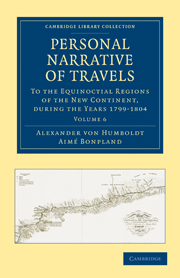
Personal Narrative of Travels to the Equinoctial Regions of the New Continent
- During the Years 1799–1804
-
- Published online:
- 05 March 2012
- Print publication:
- 02 June 2011
- First published in:
- 1826
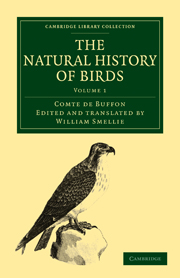
The Natural History of Birds
- From the French of the Count de Buffon; Illustrated with Engravings, and a Preface, Notes, and Additions, by the Translator
-
- Published online:
- 05 March 2012
- Print publication:
- 25 November 2010
- First published in:
- 1793
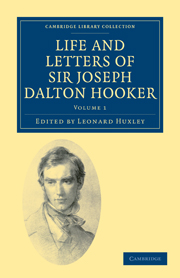
Life and Letters of Sir Joseph Dalton Hooker O.M., G.C.S.I.
-
- Published online:
- 05 March 2012
- Print publication:
- 01 May 2011
- First published in:
- 1918

My Life
- A Record of Events and Opinions
-
- Published online:
- 05 March 2012
- Print publication:
- 16 June 2011
- First published in:
- 1905
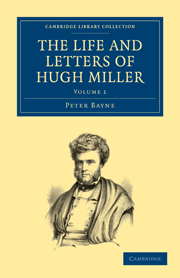
The Life and Letters of Hugh Miller
-
- Published online:
- 05 March 2012
- Print publication:
- 02 June 2011
- First published in:
- 1871
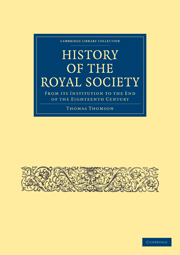
History of the Royal Society
- From its Institution to the End of the Eighteenth Century
-
- Published online:
- 05 March 2012
- Print publication:
- 19 May 2011
- First published in:
- 1812

The Works of John Playfair
-
- Published online:
- 05 March 2012
- Print publication:
- 30 June 2011
- First published in:
- 1822
BJH volume 45 issue 1 Cover and Back matter
-
- Journal:
- The British Journal for the History of Science / Volume 45 / Issue 1 / March 2012
- Published online by Cambridge University Press:
- 27 February 2012, pp. b1-b3
- Print publication:
- March 2012
-
- Article
-
- You have access
- Export citation
Daniela Bleichmar and Peter C. Mancall (eds.), Collecting across Cultures: Material Exchanges in the Early Modern Atlantic World. Philadelphia: University of Pennsylvania Press, 2011. Pp. xvi+361. ISBN 978-0-8122-4305-5. £32.50 (hardback).
-
- Journal:
- The British Journal for the History of Science / Volume 45 / Issue 1 / March 2012
- Published online by Cambridge University Press:
- 27 February 2012, pp. 128-129
- Print publication:
- March 2012
-
- Article
- Export citation
Alfred I. Tauber, Freud, the Reluctant Philosopher. Princeton and Oxford: Princeton University Press, 2010. Pp. xx+318. ISBN 978-0-691-14552-5. $24.95 (paperback).
-
- Journal:
- The British Journal for the History of Science / Volume 45 / Issue 1 / March 2012
- Published online by Cambridge University Press:
- 27 February 2012, pp. 140-141
- Print publication:
- March 2012
-
- Article
- Export citation
Peter R. Anstey, John Locke and Natural Philosophy. Oxford: Oxford University Press, 2011. Pp. xii+252. ISBN 978-0-19-958977-7. £35.00 (hardback).
-
- Journal:
- The British Journal for the History of Science / Volume 45 / Issue 1 / March 2012
- Published online by Cambridge University Press:
- 27 February 2012, pp. 129-130
- Print publication:
- March 2012
-
- Article
- Export citation
B. Ricardo Brown, Until Darwin: Science, Human Variety and the Origin of Race. London: Pickering & Chatto, 2010. Pp. ix+199. ISBN 978-1-84893-100-8. £60.00 (hardback).
-
- Journal:
- The British Journal for the History of Science / Volume 45 / Issue 1 / March 2012
- Published online by Cambridge University Press:
- 27 February 2012, pp. 135-136
- Print publication:
- March 2012
-
- Article
- Export citation
David A. Kirby, Lab Coats in Hollywood: Science, Scientists, and Cinema. Cambridge, MA and London: MIT Press, 2011. Pp. xiv+265. ISBN 978-0-262-01478-6. £20.95 (hardback).
-
- Journal:
- The British Journal for the History of Science / Volume 45 / Issue 1 / March 2012
- Published online by Cambridge University Press:
- 27 February 2012, pp. 146-148
- Print publication:
- March 2012
-
- Article
- Export citation
Books received
-
- Journal:
- The British Journal for the History of Science / Volume 45 / Issue 1 / March 2012
- Published online by Cambridge University Press:
- 27 February 2012, pp. 149-151
- Print publication:
- March 2012
-
- Article
- Export citation
Charlotte Sleigh, Literature and Science. Outlining Literature Series. Basingstoke and New York: Palgrave Macmillan, 2011. Pp. 232. ISBN 978-0-230-21817-8. £16.99/$27.00 (paperback).
-
- Journal:
- The British Journal for the History of Science / Volume 45 / Issue 1 / March 2012
- Published online by Cambridge University Press:
- 27 February 2012, pp. 145-146
- Print publication:
- March 2012
-
- Article
- Export citation
Ian Hesketh, The Science of History in Victorian Britain: Making the Past Speak. London: Pickering & Chatto, 2011. Pp. xii+229. ISBN 978-1-84893-126-8. £60.00 (hardback).
-
- Journal:
- The British Journal for the History of Science / Volume 45 / Issue 1 / March 2012
- Published online by Cambridge University Press:
- 27 February 2012, pp. 138-139
- Print publication:
- March 2012
-
- Article
- Export citation
Mark Priestley, A Science of Operations: Machines, Logic, and the Invention of Programming. London, Heidelberg and New York: Springer, 2011. Pp. ix+341. ISBN 978-1-84882-554-3. £90.00 (hardback).
-
- Journal:
- The British Journal for the History of Science / Volume 45 / Issue 1 / March 2012
- Published online by Cambridge University Press:
- 27 February 2012, pp. 144-145
- Print publication:
- March 2012
-
- Article
- Export citation
Aaron Poochigian (trans.), Aratus: Phaenomena. Baltimore: Johns Hopkins University Press, 2010. Pp. xxxiv+72. ISBN 978-0-8018-9466-4. $50.00 (hardback), $25.00 (paperback).
-
- Journal:
- The British Journal for the History of Science / Volume 45 / Issue 1 / March 2012
- Published online by Cambridge University Press:
- 27 February 2012, pp. 123-125
- Print publication:
- March 2012
-
- Article
- Export citation
Alexander Marr, Between Raphael and Galileo: Mutio Oddi and the Mathematical Culture of Late Renaissance Italy. Chicago and London: The University of Chicago Press, 2011. Pp. xvii+359. ISBN 978-0-226-50628-9. £29.00 (hardback).
-
- Journal:
- The British Journal for the History of Science / Volume 45 / Issue 1 / March 2012
- Published online by Cambridge University Press:
- 27 February 2012, pp. 126-128
- Print publication:
- March 2012
-
- Article
- Export citation
The Ivory Tower: the history of a figure of speech and its cultural uses
-
- Journal:
- The British Journal for the History of Science / Volume 45 / Issue 1 / March 2012
- Published online by Cambridge University Press:
- 27 February 2012, pp. 1-27
- Print publication:
- March 2012
-
- Article
- Export citation
